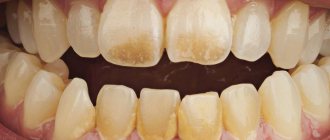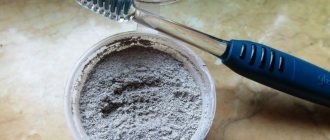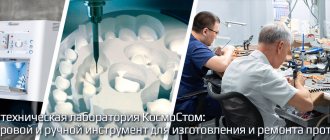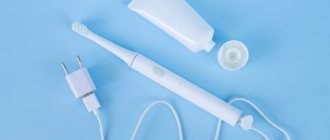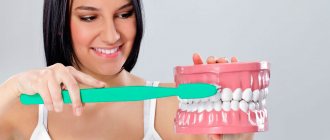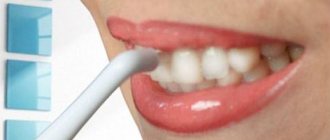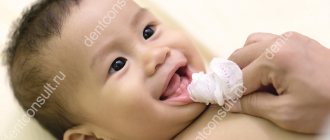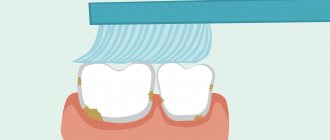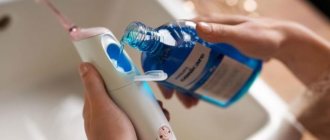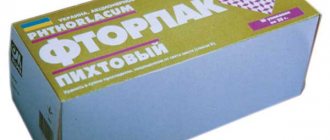Fecal coliform bacteria remain in the bathroom and are scattered throughout the room after the toilet user flushes; they can be a source of illness. You can get rid of the threat only with constant cleaning using antiseptics, but even this does not provide one hundred percent protection: particles can remain on door handles, combs and even toothbrushes.
In addition, devices for cleaning the mouth are already a breeding ground for pathogenic bacteria that remain after contact with the mucous membrane - in the future they can also cause infection. This is why it is so important to take care of their disinfection - we tell you how to approach the matter correctly.
Wash your hands before and after brushing your teeth
Bacteria and viruses are mainly transmitted through the palms - throughout the day they come into contact with many surfaces that are not always sterilely clean.
To stay safe during and after brushing your mouth, you should rinse your hands with soap and water for 20 seconds to remove any particles that might be left on the brush handle. After the procedure, you should also wash your palms to be on the safe side.
In an interview with Insider, William Martin, president of the Maryland Dental Association, said that hand rinsing should, in principle, be a basic activity of every person - it will help reduce the risk of contracting viruses and infections, as well as minimize contamination of surfaces that a person touches.
Electric brush care
In general, you need to care for an electric toothbrush in the same way as a regular one. The processing rules are not too different. The pocket with batteries and microcircuit is reliably protected from moisture, so the device can be washed without fear.
However, there are several important nuances that need to be taken into account when caring for an electric brush:
- The bristle head wears out within 3 months and must be replaced.
- Discharged batteries should never be left in the device. They may start to leak. Then not only will the brush be damaged, but the acid may get into your mouth and cause poisoning.
- After use, the electric brush should be rinsed with warm water and dried.
When trying to disinfect the device, it is important not to overdo it. Boiling may cause the product to melt. According to GOST, an indicator of 1000 CFU/cm3 of microorganisms on bristles is the norm and, in the absence of diseases of the immune system, cannot lead to infection.
Every day, billions of bacteria come into contact with your toothbrush from your mouth. Among them are streptococci, staphylococci, E. coli, porphyromonas gingivalis, herpes and hepatitis viruses A, B, C, candida albicans, coliform and many others. Improper care can lead to frequent illnesses. It is important to thoroughly wash and dry the bristles, choose a suitable place to store brushes, and observe personal hygiene rules. Every 3 months the device must be replaced.
Learn how to properly store your toothbrush
The American Dental Association says it should be rinsed thoroughly under running water to remove any food, toothpaste, or tartar. After this, you should leave the brush to air dry in a vertical position - most bacteria die in an aerobic (oxygen) environment.
It is important to store the brush not in a case or small container, but in a spacious place, for example, a cabinet next to a mirror: the fact is that pathogenic particles may remain on the boxes for the device. Also, the brush should be left as far as possible from the toilet and be sure to close the lid before flushing it. You should also avoid leaving multiple brushes nearby, as germs can spread when they come into contact.
When does a brush become dangerous?
American scientists have found that on average, about 100 million microorganisms live on a toothbrush that is stored open. Among them are staphylococcus and other bacteria that can lead to infectious diseases.
After brushing their teeth, the average user simply rinses the brush with tap water. But such cleaning is not effective. At best, water only washes away food debris and surface contaminants, but is powerless against microbes. If your toothbrush is left untreated, bacteria will accumulate on it, increasing the risk of tooth decay, canker sores, bad breath and other dental problems.
Disinfect the brush
If you want to take extra precautions, or if you dropped the device on the floor, you can use hydrogen peroxide or mouthwash.
The first solution is a good antiseptic that destroys harmful particles picked up by the brush from the ground. The second contains alcohol, menthol and eucalyptol, which also help get rid of bacteria. To do this, rinse the bristles under running water, pour a little antiseptic into a glass - enough to cover the brush head, and soak the device for 10-15 minutes. Afterwards, rinse it again and leave it to dry in the open air.
Read on topic:Why and how to cleanse makeup products
Best models
There are different types of sterilizers available on the market. Let's look at the most popular ones:
- Gezatone T4 . Designed in France and holds four brushes. Looks like a convenient closed glass. Its lid has 4 cavities for personal care items. A plus is the presence of a tray for draining water, so the device will last longer.
- Esencia ESA-555 . A very practical device, as it has the ability to disinfect brushes, a machine and manicure devices. This is a universal option. It mounts to the wall and includes six holders and a tray. This manufacturer from South Korea has other models: Esencia ESA - 600, Esencia ESA - 300/302 and others.
- Recesky . Manufacturer – China. The device is designed for one item, but is very popular among consumers. And all thanks to the interesting design that children will really like. Each oval model comes in the shape of a panda, penguin, owl or ninja. The device is small in size, so it is convenient to take on trips.
- Timson is a popular compact model made in Russia. The sterilizer is designed for a single brush. The disinfection process lasts seven minutes. You can track how the device works through the upper part of the case, which is specially made transparent.
- Zero germ . Another portable device with an original design, made in China. Eliminates all germs in six minutes without damaging the bristles. Well suited for use at home and while traveling.
Use ultraviolet light
According to a study published in the American Journal of Dentistry back in 2008, UV light kills bacteria and some viruses by disrupting their molecular bonds. It also found that light was slightly less effective than alcohol or peroxide, but if you have an ultraviolet lamp on hand, this is a good way to use it.
Leave the brush next to it for a few minutes, then air it out in the open air. We do not recommend using a dishwasher or microwave as an alternative - the high temperature inside the equipment can damage the brush or even melt it.
Application of dental sterilizers
There are different methods for disinfecting toothbrushes; sterilizers are excellent at disinfecting bristles.
They can be used both at home and while traveling. High-quality cleaning of the bristles will help avoid the accumulation of harmful bacteria on it. Of course, you can use regular soap for this purpose, but it is better to give preference to a sterilizer. This is a modern device in which the necessary hygiene item will be qualitatively treated with ultraviolet light, which will almost completely destroy all germs and make the teeth cleaning procedure as effective and safe as possible.
Advantages of ultraviolet sterilizers for toothbrushes:
- destruction of up to 99.9% of all pathogenic bacteria and microorganisms;
- convenience and ease of use;
- in models with large capacity, razors and manicure accessories can be disinfected;
- disinfectors are made of safe ceramic material with good antibacterial properties;
- Low-power ultraviolet lamps in the device are safe for the human body.
It is important to remember that although using a disinfectant helps the bristles remain elastic longer, you need to replace your toothbrush regularly.
Design features
The sterilizer has a fairly simple design, which includes a case for personal hygiene items and a built-in ultraviolet lamp. For the manufacture of cases, bioceramic material is used, which has antibacterial properties.
Most models have special covers made from plastic. It guarantees good protection against the harmful effects of ultraviolet radiation.
The case can be of various shapes. You can choose the classic type, it is compact and made in the form of an interesting geometric figure or toy. There are special holders installed inside the disinfector where brushes are placed.
Some models have several built-in holders, which is convenient for the whole family. In others, they may not exist at all. The lamp in each device is located so that all bristles will be cleaned and disinfected, regardless of what they are made of or how many there are.
Principle of operation
The sterilization process itself is very simple. When you need to disinfect your toothbrush, place it in the case and close the lid of the device well. Then it will do everything itself: it turns on, sets the disinfection time, performs the work and gives a signal that the procedure is over.
Microbes, bacteria and fungi die under ultraviolet rays. Exposure to a special lamp will give an antibacterial effect. Most models are designed so that the device starts working as soon as the lid slams shut.
Disinfectors can be used not only to disinfect brushes, but also to store them there. Because the device will maintain the sterility of the object located in it even after the antibacterial cleaning process is completed.
The sterilizer requires batteries or an electrical outlet to operate. It is absolutely safe for humans, because the device will not turn on if the lid is open. There are models with ultraviolet and ozone treatment, devices with a timer and manual control of operating time.
Variable solutions
Today, different types and models of disinfectants are offered on the market. The most popular options are those that can be used both at home and while traveling. These are very compact portable sterilizers in the form of a case for one hygiene item.
For home use, it is better to purchase a glass-shaped device. It's perfect for the whole family because it can hold up to six items. And thanks to its simple operation, even children can use it. Universal models are very popular, where it is possible to simultaneously irradiate brushes, razors and manicure accessories.
You can choose an option to suit every taste. Sterilizers are affordable for everyone. This useful purchase will help keep your teeth healthy for a long time.
Keep your brush safe while traveling
To ensure that it does not become a breeding ground for bacteria, get a separate case or cosmetic bag where only the cleaning device will be stored.
Upon arrival, unpack your things, leaving the brush in the bathroom and rinsing it first. Before you leave, rinse it, dry it thoroughly, disinfect the storage case and place the brush in it.
Storage rules
Germs simply love dark, damp, cool places, like the bathroom. In such conditions, they remain viable for a long time and reproduce. For example, on a poorly washed wet brush. The correct way to store it is as follows:
- Use a special vertical cup with a separate hole for each toothbrush. It is important to avoid cross-contamination from other surfaces, including brushes from other family members.
- Take care of ventilation. The washed bristles should dry completely. Do not place the brush directly into the container. By and large, it is intended only for transportation or storage on the road.
- For a shared bathroom, choose a storage location away from the toilet. When flushed, harmful particles enter the air and then settle on nearby surfaces within a radius of 1.8 m. If it is impossible to move the brush over such a distance, you should purchase a protective cap with ventilation holes.
- Keep the brush storage container clean. Wash the cup or holder at least once a week with soap and hot water. To remove stains, use baking soda and a sponge that has not been used on the sink or other surfaces.
Duration of operation
Each dentist may give different advice regarding the duration of use of one device. The best option is one month, but up to 100 days is acceptable. You can purchase special brushes that have wear indicators.
You need to buy a new item in the following cases:
- service life exceeded 3 months;
- after suffering from any diseases of the gums, teeth and oral cavity, including runny nose and common colds;
- the bristles began to “look in different directions”, some of its elements became bent and worn out - in this case, brushing your teeth will be less effective.
The note. Before the first use, simply rinse the purchased device in running water, after soaping the bristles.
What happens if you don't do this?
If you do not disinfect on time, you can complicate your life. After all, the human oral cavity is inhabited by a variety of microbes.
Note! While everyone knows that it is necessary to brush your teeth every day and rinse your mouth with a special solution, many people do not think about the fact that they take care of their hygiene items.
In order to prevent the spread of harmful bacteria, disinfection measures must be taken.
If this is not done,
bacteria will multiply and the likelihood of various diseases will increase.
